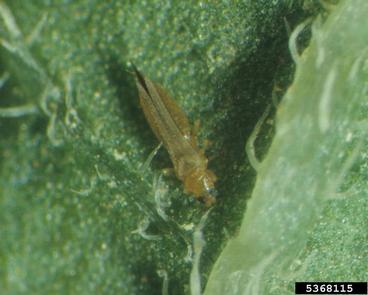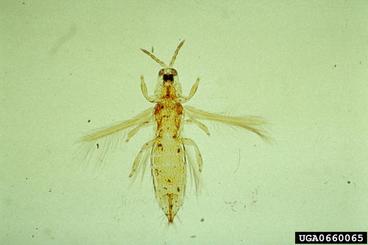SCIENTIFIC NAME: Thrips palmi Karn
CLASS: Insecta
ORDER: Thysanoptera
FAMILY: Thripidae


Description
Adults
Melon thrips have a clear yellow body without darker blotches but with thick, blackish body setae. Antennal colors variable. The pronotum has two pairs of major setae and posterior angles and antennal segments 3 and 4 each have a forked sense cone.
Eggs
No description available.
Larvae
No description available.
Pupae and prepupae
No description available.
Biology
Distribution
The melon thrips was first established in the United States in Hawaii around 1982. An established field population was first discovered in the continental United States in 1991 in Florida. It has been distributed in South and Southeast Asia, Pacific Islands, and Caribbean Islands.
Host Plants
The melon thrips has an extremely wide range of host plants, including nearly all kinds of vegetables, many fruit trees and weeds, and several flowering plants such as chrysanthemums and carnations. They quickly build up heavy infestations causing severe injuries.
Damage
Immature thrips and adults feed on leaves, (first along midribs and veins), stems (near growing tip), flowers (all parts), and fruits (on the surface). Severe damage results from sucking plant sap leaving silver scars from empty cells. Heavy feeding results in a silvered or bronzed appearance and will kill the plant.
Life Cycle
The melon thrips eggs are deposited within plant tissues singly. Larvae have two stages that feed on plant tissues. The second instar larvae, when mature, fall to ground, where the molt to prepupae and pupae in the soil. After emergence, the adults move to the growing parts of the plants such as young leaves, flowers, or young fruits, where they feed and lay eggs. Adults are usually found on young leaves, while larvae are found on lower or older leaves. Few thrips are found on flowers or fruits. At higher temperatures generation times are shorter. The average development times are: 80.2 days at 15° C, 40.7 days at 20° C, 24.8 days at 25° C, and 20.5 days at 30° C. The reproductive rate reaches maximum at 25° C. The adults reproduce sexually and parthenogenically.
Management Strategies
Chemical insecticides have not been consistent in controlling this pest. None cause more than 80 percent mortality. Several predators attack the melon thrips, including predaceous mites in the genera Amblyseius and Phytoseiulus (Acari: Phytoseiidae), insidious flower bugs, and several species of predaceous thrips, ants, and rove beetles.